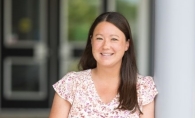Elementary school isn’t what it used to be. For the past year, first graders in teacher Christina Hayden’s class at Matoska International IB World School in White Bear Lake have been learning a valuable 21st century skill by using a new iPad app to program and code the type of robot that might be used in a high-tech manufacturing setting. The Osmo Coding Technology enables students to use hands-on physical blocks to control Awbie, a playful character who loves strawberries. Each block is a coding command that directs Awbie on an adventure. The interactive hardware helps them learn logic and problem-solving skills.
The Osmo Coding Technology was acquired using a $2,172 grant from the White Bear Lake Area Educational Foundation. The foundation’s Brosious Grant program has also funded coding programs at other elementary schools. It’s one of many examples of the impact made by the White Bear Lake area’s four, major educational foundations: the White Bear Lake Area Educational Foundation (WBLAEF), the Mahtomedi Area Educational Foundation, the 916 Education Foundation and the Century College Foundation.
Each of the foundations is an independent, 501C-3 nonprofit organization. They provide funding for innovative educational projects that wouldn’t be financed through the traditional state government channels. They also provide other forms of support for students and teachers.
White Bear Lake Area Educational Foundation
The WBLAEF directors and staff—like the educational foundations in the area—prides themselves “on supporting innovative ideas and concepts,” says executive director Dawn Hank. Those ideas can come from teachers, administrators, parents or students.
Not everything the foundation does is high-tech. It also has a fund to help needy students and families (for example, after a house fire) with basics like temporary housing, prescriptions, replacement eyeglasses and other necessities. Part of that effort is The Closet, an extension of the Angel Fund and a place in the White Bear Lake Area Learning Center, the district’s alternative learning building, where families in the district can shop for gently used clothing.
Since its inception in 1993, the WBLAEF has awarded more than $300,000 in teaching grants to enhance curriculum, granted more than $150,000 for teacher professional development, presented $330,000 in scholarships to graduates, provided more than $140,000 in financial assistance through its Angel Fund and granted more than $22,000 to support elementary art education.
It has also awarded $30,000 in grants to teachers — enhancing environmental experiences and awareness for students; and, since 2014, provided $30,000 to community members, staff and students, encouraging initiatives around innovation, creativity, community and global projects.
Each of the local foundations stages annual or bi-annual fundraising events. WBLAEF stages two annual fundraising events, a golf tournament in June and the Bear Legacy gala in September.
Mahtomedi Area Educational Foundation
Now in its 29th year, the Mahtomedi foundation awarded $400,000 in educational grants in its most recent fiscal year, according to development director Kevin Donovan. Board Chairman Mike Connolly also leads the mission “to maximize our ability to help people realize that every donation can make a difference,” Connelly says. He got involved after the death of his father, James J. Connolly, in 2006, and the family established a scholarship to benefit graduating seniors.
Corporate giving is an important source for foundations. Anderson Windows’ corporation foundation provided a grant to finance development of a fabrication lab to help students learn about high-tech manufacturing, such as 3D printing. Mahtomedi is the first E (elementary)-12 district in the country to develop such a lab, Donovan notes.
Obviously, the foundations help schools, teachers and students keep pace with rapidly evolving technology. But that’s not the whole mission. “It’s also important to fund things that are not just technology-based,” Connolly says. Things like paint teachers can use to transform walls into whiteboard space, or redesigned desks to make it easier in sign language classes to use their hands. Because of the “huge” economic diversity within the district, the foundation also plays a role in ensuring students from less affluent homes have “food security,” and basics such as backpacks and school supplies, Connolly says.
Century College Foundation
Another local foundation is the Century College Foundation, which awards more than $300,000 annually in student scholarships. Executive director Jill Greenhalgh sums up the foundation’s mission as “transforming lives one student at a time, by creating opportunities and supporting their successes.”
That might mean helping a student pay tuition, connect with a scholarship opportunity or providing some type of emergency assistance. In the latter category, four years ago the foundation helped set up a food pantry on the Century College campus. One of the foundation’s other, unique programs is Random Acts of Kindness, which helps students in crisis situations stay in school instead of dropping out.
One recent example of a student helped by the foundation is Mary Vang, who had been a University of Minnesota business major but “discovered her true passion” taking science classes at Century, and is now on a path to a medical career. The foundation helped Vang obtain a research internship at the Mayo Clinic in Rochester, Greenhalgh says.
916 Education Foundation
One recent trend is that foundations put more and more resources into classroom enhancement, says Gary Benson, board member and past president of the 916 Education Foundation. “It’s become more and more difficult for school districts to come up with operating capital to fund educational needs beyond the basics. Because of the transformative impact of technology on education, there are so many opportunities out there,” Benson says.
The 916 Education Foundation covers a large geographic area, serving 14 different school districts in the East Metro area. “We have a far-reaching mission,” Benson notes.
In May, the foundation awarded $28,250 in post-secondary scholarships to 45 graduating students who studied at career and technology centers and area learning centers within its service area. Recipients’ career areas included law enforcement, medical, construction, computer hardware/software, dental, design and digital media. Each fall, the foundation provides about $40,000 to fund program grants and staff recognition efforts.
Working Together
The local foundations also collaborate on projects. Once a year, the Mahtomedi, White Bear Lake and Century College foundations come together to honor an Outstanding Volunteer of the Year. Recent honorees have included Greg Bartz, well known for his charitable work locally and internationally with the White Bear Lake Rotary Club, and Bill Foussard, a tireless volunteer who, among other efforts, co-founded the Thanksgiving Meals on Wheels program in St. Paul.
Foundations can do great things, but individuals make their work possible, Greenhalgh points out. “No gift is too small or too large to make an impact on a student’s life. Through the power of generosity, people have the opportunity to do something remarkable.”









